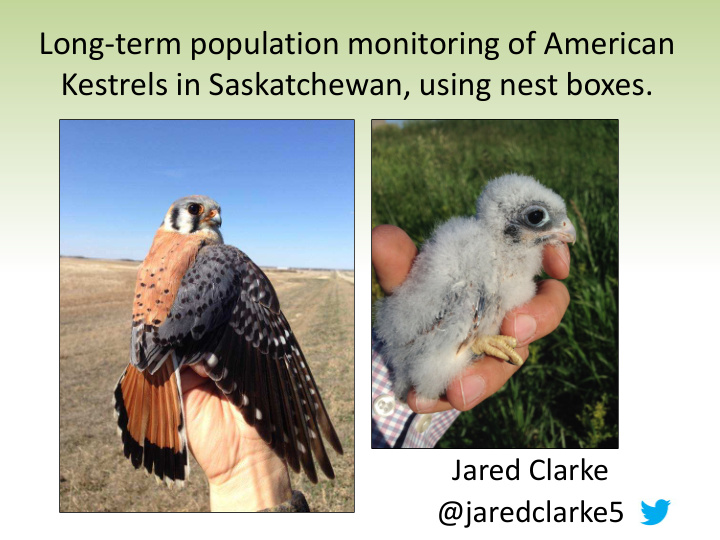



Long-term population monitoring of American Kestrels in Saskatchewan, using nest boxes. Jared Clarke @jaredclarke5
Getting started • 2007 – put up 2 boxes around Regina – both were occupied! • 2008 – put up 14 boxes – 8 were occupied! – banded 8 adult females & 30 chicks! • 2009 – had 11 boxes – again 8 occupied! – banded 6 adult females, 4 adult males & 8 chicks.
2015 – Let’s Get Serious! • Goal: Set up a long term nest box program to study American Kestrel population in Saskatchewan. • Set up study to reduce driving and time commitment for each 300 km bander. 186 miles • 5 banders & each bander had a cluster of 10 boxes to monitor. 2015 – 50 boxes 2016 – 79 boxes 2017 – 60 boxes?
• Standardized the boxes (Audubon Society/Art Gingert) • Boxes placed at least 1 km apart • Set up on power poles and trees • Checked at least twice per year beginning and end of May, more if AMKE present • Clean the boxes each winter
• Catch females in the nest box by plugging the entrance hole • Males are opportunistically captured with a bal-chatri
Results • 2015 (50 boxes) 8% active nests (n=4), 2 successful Banded 3 adult females, 1 male & 10 nestlings 50% occupancy by European Starlings (n=25) • 2016 (79 boxes) 12% active nests (n=10), 7 successful Banded 7 adult females, 0 males & 35 nestlings Recaptured 1 male from 2015 59% occupancy by European Starlings (n=47)
2015 10 # of boxes 8 6 4 2 0 Prince Albert Saskatoon Nokomis Herbert Edenwold Regina Empty Active Starling Nests Active Kestrel Nests 2016 20 18 16 14 # of boxes 12 10 8 6 4 2 0 Prince Albert Saskatoon Nokomis Herbert Edenwold Regina Location
A couple other interesting things
Thank you to my team: Randy McCulloch (Herbert) Joseph Kotlar (Nokomis) Adam Crosby (Saskatoon) Matthew Tokaruk (Prince Albert)
Recommend
More recommend